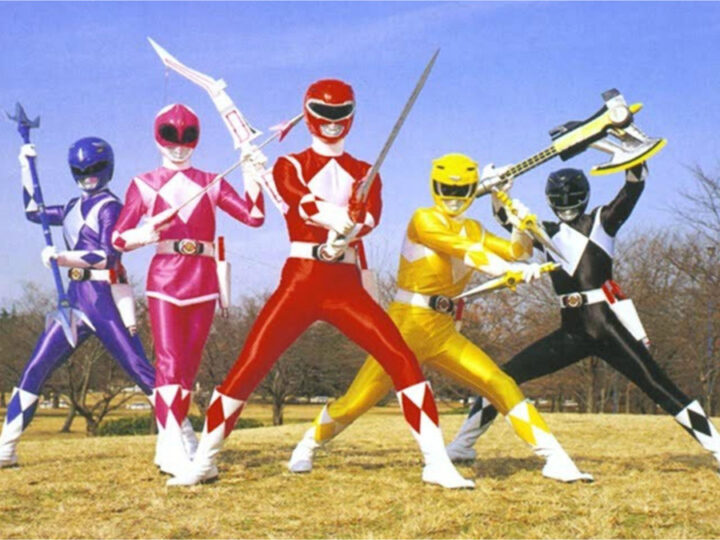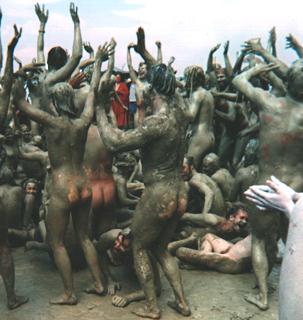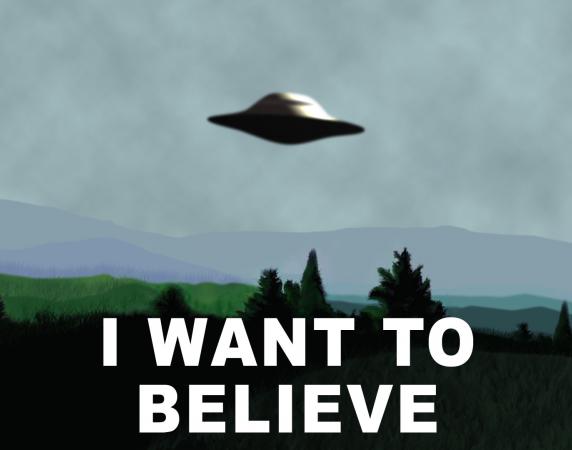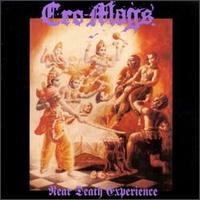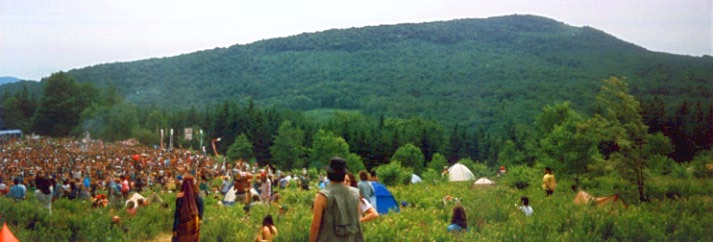
Hippies, Faeries, and Hoboes at the 20th Rainbow Gathering
GREEN MOUNTAIN NATIONAL FOREST, VERMONT: A young backpacker with short hair and jeans stands on a rock surveying the riot of color and scruff around him: tents draped with scarves, bands of face-painted kids, verdant hills, hairy people hanging around waiting for cookies. “It’s my first Gathering,” he says, taking in the scene. “I’m being pulled in so many directions. I guess I’ll go where my karma takes me.” He smiles and wanders off.
In most of America, language that would leave an aftertaste as moldy as ancient bread. But as the witches of Salem and the inventor of LSD knew, bread mold carries magic fungi, and my man’s mind-frame was ideally suited for the vivid space he had just entered: the 20th annual Rainbow Gathering, described by the old Rainbow hand Plunker as a “hippie Disneyland.” Surrounding the backpacker were the Rainbow Family of Living Light, a loose-knit spiritual community of peace, love, and anarchy, 17,000 large. By hiking in, he had joined the family.
Since 1972, the Rainbows have been alighting the first week in July on National Forest land, and this year they invaded the groves and meadows of the Green Mountains. In the spring, the New England regional Rainbow families had sent out “Howdy Folks!” newsletters inviting any and all to join in the necessary consensus decisions, sites, finances, politics. By early June, Rainbows were already arriving for seed camp. Water pipes were laid, kitchens built, shitters dug. Hundreds and then thousands flocked, and by the first week in July, a nomad village had blossomed.
A village map was nailed up at Info Center, along with environmental petitions and announcements for workshops on Elvis Consciousness, Tantric Sex, and Job-Free Living. Hundreds of kitchens and camps sprouted up: Pagan Place, Jesus Camp, Pooh Corner (latrines), Cyberspace Salon, Emerald City. But for the map to unfold, you have to wander, and plunge into the Gathering’s festival of signs. Here a Ronald McDonald doll with a third eye sewn on; there a spontaneous poet named Norm, dressed in a potato sack, singing “We Vishnu a Hare Krishna.” Loosen up, and the Gathering reveals itself as performance art on a mass scale, an organic virtual reality where leaps are rewarded, bullshit grows mushrooms, and bum mind-frames snap back in your face like rubber bands.
Here, amidst the pines and meadows of unspoiled Vermont, the Rainbow tribe takes on an ancient, pagan glow. Out from between Park Avenue Deadheads and heavy-metal burnouts appear gypsies and griots, hicks and hoboes, Faeries and harem dwellers, Indians, jesters, and 19th century utopians with bushy, serious beards. In the world, many are social workers, drug dealers, caf waiters, undergrads. But here all transform into a timeless crew of nomads, trailed by rags and incense.
Materials come and go, goods are scrounged or bartered, technology jerry-rigged from branches and solar cells. Except for backwoods drug deals, no currency is exchanged at all, no “green energy.” “M&Ms and sage to trade for any kind of mind intoxicants” reads a passing sign, and at the trade circles one finds jewelry, condoms, tarot readings, knives, souvenir Rainbow Gathering walking sticks, monster quartz still with Arkansas soil. Commodity values become magical. A man at the Nevada Gathering got a whole tent for a bite-size candy bar, and my buddy Eddy Nix told me, “If you have a Snickers bar in your pocket, some rocks, a pack of cigarettes, you can get anything you want.”
Late my first night, sweaty men and women beat the skins around the Drum Circle’s pit of fire. A few brothers try to introduce true polyrhythms into the sea of beats inspired more by soundtracks to westerns than by Tito Puente. But that’s the Gathering–as one man said, “Everybody’s either an expert or a blisser.” The complex clusters of polyrhythms come and go in the cold night air, they crystallize and decay. The waning moon rises above the trees as a mesmerized woman partially disrobes. The crowd starts singing the Brady Bunch theme song. I’m not sleeping tonight.
***
For my twentysomething generation, there is no counterculture, only subcultures. Hippies are just figures on a screen, their stories received text, their images store-bought T-shirts. “The ’60s” was a party we came late to, and while some of us picked around, leafing through the stained magazines and playing the scratchy records, that era’s sense of imminence eludes us. For all I and any of the many Rainbow young’-uns know, the Gathering could not only have been a ’60s retread, but a very flat one at that.
Most of the ’60s vets I spoke to seemed a little wistful. Eric Sterling, a progressive lawyer from D.C. and a “plainclothes freak,” felt the crowd at the Gathering lacked the vibrant creativity of the early hippies he’d hung with in Oregon. “It’s less like a wave and more like a holding pattern,” he said. “This tie-dye shirt I’ve got on now is part of a suit,” Sterling told me. “I’m not kidding. I bought it at a Dead show a few years ago, and there’s a matching pair of pants. And in my car, I’ve got my other suit, the one I wear to work every day.”
What 25 years ago was an explosion of novelty has now become a conservative code for the young. No longer signifying rebellion or a generational concentration of power, hippie fashion now indicates a specific subculture with specific signs, a subculture predominantly rooted in middle-class, suburban environments. For all its autonomy, nomadism, and authenticity, much of the Rainbow reflects the anxieties and needs of that class, and is limited by the genre conventions of that lifestyle. “It’s like an incredibly organized, giant hippie frat party,” said J.P. Harpignies, a former radical who came to the Gathering looking for a spark and found a wet blanket.
That’s one of the reasons the Rainbows relentlessly cannibalize other forms, the most notably being Native American culture–teepees, feathers, sweat lodges, even the “Ho!” barked out at Council as a sign of assent. As a lover of sweat lodges and a firm believer in cross-culture sampling, I can’t fault this passionate eclecticism. But the images projected on Native Americans ring false, especially considering how uncritically tribalism is accepted as a social form. As J.P. said, there’s part of all of us that yearns for tribal identity, because the family is a joke, and none of us feel connected. But there’s something sad and depressing about this sort of random gathering for no reason other than to celebrate your ethos. It becomes not that different from a bunch of Baptists meeting outside of Forth Worth.”
There were plenty of folks who seemed stuck in a rut. One bearded, diminutive creature shuffling about in a blanket and unlaced hightops looked so much like Charles Manson that I shivered whenever people mentioned how wonderful the “Family” was. Then there were the wild-eyed youths jonesing like drunks for doses, and the sleazeballs with their “I have psychic powers baby” glow–though as one young sister put it, “It’s better to get hit on at a Rainbow Gathering than the city. Here they’re more creative.”
The Rainbow is too earthy and vibrant for the pale pastels of the New Age, but a creepy logic of self-serious purification lurks in the wings. When entering the Gathering, you’re hit with “Rap 151,” which strongly discourages the use of alcohol. But some Rainbows, including authentic hoboes, are alcoholics, and many of these folks do the most grueling work, coming early and staying long, through the arduous process of dismantling the camps and “disappearing” as many human traces as possible. At the Gathering, they were segregated into “A-Camp,” which revealed itself as the Rainbow’s projected shadow. The majority of the rumors floating around concerned the evil, drunken “A-Campers”–they attacked cars with axes, demanded passage money, blocked entry to Krishnas and Faeries, assaulted a ranger’s son. Some were true, most false, but many people spoke of the need to eradicate the scourge.
The relationship between the Rainbows and the drunks reminded me of the time I hung out with a bunch of New Agers along the California/Mexico border, awaiting the Harmonic Convergence (don’t laugh, I saw my first UFO). A sweat lodge had been set up, and this Vietnam vet and I were talking nearby, drinking white wine out of a plastic water jug while the folks inside sang “Give Peace a Chance.” A woman smelled the wine and turned to us aghast: “This is a sacred space! No alcohol energy!” We scooted away and then this wise, broken man told me tales of Indians he’d known in Oklahoma; how they’d taken him out trapping with hangers and wire; how trashed they’d get on cherry wine.
***
Though a museum of hippie codes, the Rainbow Gathering demands to be seen in the broader context of American utopian communities. But this family’s anarchy, technological complexity, and physical mobility mark it as exceptional. Garrick Beck, an original Rainbow and son of Living Theatre founders Julian Beck and Judith Marlina, described it thus: “It’s not a religion, and it’s not a nation-state. It’s a functionally sound, ecologically aware community. We’re not authoritarians, and just about everyone’s having a wonderful time.” But half the joy of the event comes from its own construction.
“Anarchy means without leaders; it doesn’t mean that there’s just chaos everywhere,” said Peaceray, who works for a major telecommunications firm in New Jersey and uses his laptop when acting as “scribe” for Council meetings. “It’s like when a body grows, a cell takes on a certain responsibility, becomes bone or skin. At the beginning the cell might not even know what it’s doing.” This sense of communal construction impels some people to casually shuck corn or babysit, while others devote themselves to building, cleaning, or healing. The sweat of tall, lanky Adam kept Pancake Paradise going, as he hauled huge logs, chopped wood, and battled with the lower camps over control of the water source. “I live this way most of the year,” he said. “I only do a Babylon trip once in a while.”
As an organization, the Gathering falls somewhere between a summer camp and a state of emergency. “One person can go to the john, not wash their hands, cook food, and 1000 people get sick,” said Gabe Kirchner, referring to the North Carolina Gathering, which was visited by a strain of diarrhea far more vicious than the usual Rainbow runs. At Vermont, a baby was born, a baby died, a man broke his back. Rapes and child molestations have occurred, and now the Rainbows have put a system of security–Shanti Sena–in place.
The “politicos” here were most visible at dinnertime in the Main Circle, when the self-elected would hold sway with the feather that designates the speaker. (The Rainbows used to use a staff, but women thought it was too phallic, so they tried a bowl, and then settled on the current token, figuring that guys would look pretty stupid stamping around with a feather.) Before kitchen folks started dishing out salad and spoonfuls of spaghetti from plastic garbage cans, these politicos would meander on aimlessly about the need to “focus,” and drop millennialist junk like: “We’re the magic people the world has longed for.”
The fifteen or so folks at Tea Time demonstrated how free zones develop even within the Gathering. One of the more happening spots, Tea Time served up tasty brew 24 hours a day, and was periodically visited by the Mad Doser. “At Tea Time we’re autonomous,” said Brian, a sandy-blond homeless man of Turkish descent. “We never acknowledge the Council, we never acknowledge the feather.” Gesturing toward a Confederate flag, Brian said it meant that “we support secession from the Union, not necessarily what the states then supported.” Standing beneath a sign that read “No Traders (Traitors)–Let It Be Free,” this friendly man in a Joker T-shirt later admitted that there were good things about David Duke.
Brother Brian aside, Rainbow politics were a decent blend of cultural radicalism, peace activism, and conspiracy theory (some whispered that just before the North Carolina diarrhea broke out, a mysterious plane was seen spraying near the ground). The Gathering was an open field of communication, where the entire body became a node, and local communities formed spontaneously. Asking people where they were from was as tenuous a question asking them what they did, so you’d just shoot the shit: how you got here, the trips you’ve taken, your local knowledges–herbalism, minerology, kabbalah, transmissions from Sirius. How to make pot pipes out of picnic tables, how to fly cheap to Amsterdam, how to drop fresh water on cowboy coffee to make the grounds sink to the bottom, how to grow witchcraft corn.
These are the marginal networks of knowledge, and they even took on the form of a counter canon: High in the pines, some mad fools had schlepped crates of books and set up a Metaphysical Library of head booksRobert Anton Wilson, Secret Teachings of the Ages, Bukowski, The Sacred Mushroom and the Cross, Jung, The Book of Thoth, Joyce, William Gibson. This space drew dataheads and cybernauts–a guy who’d bicycled through Russia with a Toshiba laptop, solar cells, and a printer; an Atlantan who told of the Mothership, a roving data center of computers and peace information.
***
Though there were still more Waspafarians than Rastafarians at the Gathering, more and more people of color are joining in. Faeries, dykes, punks, and pagans set up camp, as do some homeless men and women from Tompkins Square. Sun Bear, an older New Hampshire man with a huge floppy hat as big as his beard, described the magic made of such kindness and lack of prejudice. “To be in the dark, with hundreds of strangers all around you, and not to be scared. Blew my mind.” At the other end of the universe, there was the San Franciscan Stephen Maxxxine, lounging in the lacy and lovable Faerie Camp, dressed in shorts, eyeliner, a red Harley-Davidson cap, and Levi’s jacket with Druids and Kawasaki patches stitched on. “We’re the lavender stripe in the rainbow,” he said, rolling a Drum. “I always walk around with urban armor, and Gatherings are the only place I can walk around without that armor in a dominantly straight society, and feel totally accepted.” Though he acknowledged that there was some harassment from newcomers, he also knew that no straight Rainbow would put up with any bashing. When I left, he was whispering about plans to steal the prize possession of Vermin, the venerated mayor of Faerie Camp: a scepter topped with a disco ball.
The Gathering not only embraces folks at the margins of hippie, but the physically marginalized as well: the blind, the old, the wheelchaired. “Elders” were in full force, and there were hundreds of families. The Rainbow rhetoric of tribalism is enacted on a broader social plane than that of the Beats or even first-generation hippies. Beneath its crunchy veneer, the connections drawn between young and old, gay and straight, homeless and rooted, god and partying, all begin to resonate in a great tribal rush.
No wonder the Gathering draws so many young people. For these ’80s kids, it is not so much a costume party as a social theater that creates nomad zones in the oppressive grids of radically commercialized youth culture and suburban anomie. “The Gathering shatters the misconception that you have to be part of society in a certain way,” said Sunflower, a 15-year-old, freckle-faced girl from Boston. “Everywhere you get messages telling you how to live, from media and parents. You can do other things, it’s not just a fantasy lifestyle. People do live in this other way, are happy that way, and have success in other ways than those we’re taught to expect. I don’t think that if all of a sudden the Rainbow Family said, ‘We’re the new government,’ it would work. But on a small scale, it does work.”
The Rainbows cooperate with the forest rangers, who test soil and water and check up on sanitation at the camps. Rangers from around the country are also flow in to set up an Incident Command System nearby, a form of state power as nomadic as the Gathering itself. “It’s really not much different from fire camps out West,” said a smiling local ranger. “The organizational structure is the same.”
The Vermont rangers were mellow, but plenty of the national and Southern rangers aren’t. In fact, ever since Governor John Love and hundreds of Colorado State troopers tried to stop the first Gathering at Strawberry Lake in 1972, the most explicitly political activity of the Rainbows has been directed against the authoritarians who would shut them down. For the last ten years, the only “permit” the Rainbow Family has used is the First Amendment, with its assurance that the people have a right “peaceably to assemble.” The last regulations the D.C. politicos drew up were found by Judge William W. Justice to be “repugnantly unconstitutional.”
Though it’s hard to focus hippies for long, the Rainbows have the distinct advantage of grounding their peace, love, and anarchy in the practice of the Gathering, which potentially gives them as solid a spiritual foundation for activism as politicized Christians. There was little sign of the recent war, but a good ol’-fashioned flag burning on the Fourth did get some rebel blood going. On Saturday, a crew of demonstrators when to Montpelier to protest James Bay hydroelectric project. But, like squatters, the Rainbows devote much of their political energies to the continual recreation of autonomous space.
Most Rainbows would argue that they are gathering “for world peace,” and that the energy generated in the ritual silent ceremony on the Fourth of July will itself make for a Smilin’ Gaia. Today, this sense of imminence may seem like a ritualized trace of Sixties messianism. But it must be said that on the Fourth, as a parade of children were led into the silent Main Circle, the haze began to break and a rainbow appeared, wrapped around the sun. The crowd was stunned. “It’s the marriage of Father Sky and Mother Earth,” said a cook from Wandering Lotus camp, a Trinidadian East Indian who was soon to embark upon a world tour. Then dj vu hit: just that morning, I had randomly opened up a book of poetry to Thomas Vaughn’s “The World,” in which the poet sees Eternity as a “great Ring of pure and endless light” that seems to mock the world. But in the final couplet he realizes that
This Ring the Bridegroom did for none provide
But for his bride.

